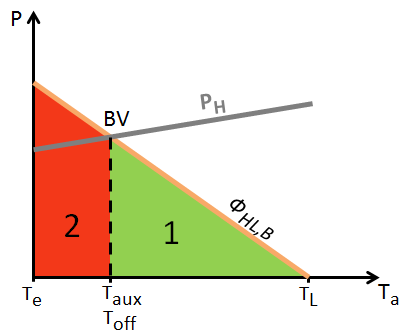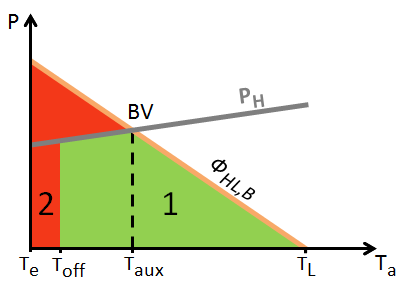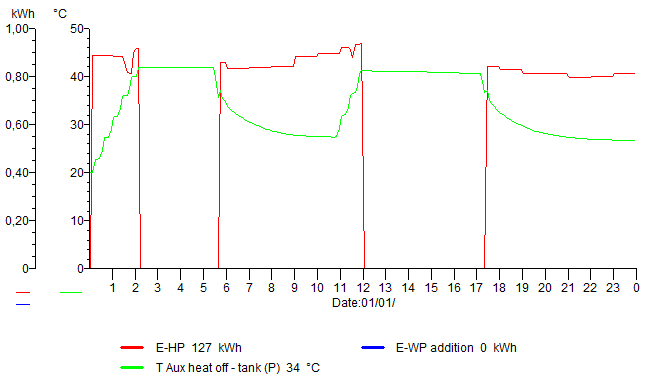Monovalent
The heat pump is capable of providing sufficient space heating, even in extremely cold outdoor temperatures. There is no need for an additional heat source, as the heat pump can handle the heating requirements entirely on its own.
Monoenergetic-alternative and bivalent-alternative
The heat pump operates independently when the temperature is above the switching threshold. It efficiently provides the necessary heating without any assistance. However, when the temperature drops below the switch-off threshold, the auxiliary heating system takes over and operates on its own to provide the required warmth.
Monoenergetic-parallel and bivalent-parallel
The heat pump operates independently and efficiently up to the cut-in temperature. However, when the ambient temperature falls below this threshold, both the heat pump and the auxiliary heating system work together simultaneously to ensure optimal heating performance.
Monoenergetic-partially and bivalent-partially
The heat pump operates on its own when the ambient temperature is above the switching temperature. In the range of temperatures between the switching temperature and the switch-off temperature, both the heat pump and the auxiliary heating system work together simultaneously to provide heating. However, when the ambient temperature drops below the switch-off temperature, the auxiliary heating system functions independently to meet the heating requirements.
| Legend | |
|---|---|
| $1$ Heat pump | $T_{a}$ Ambient temperature |
| $2$ Auxiliary heating (heating element) | $T_{L}$ Heating temperature limit, approx. 20°C |
| $P$ Heating load | $T_{aux}$ Cut-in temperature of the auxiliary heating |
| $P_{H}$ Heating load, covered by the heat pump | $T_{off}$ Switch-off temperature of the heat pump |
| $BV$ Bivalence point | $T_{e}$ Standard outdoor temperature, approx. -15°C |
| $\Phi{HL,B}$ Heating load of the building |
Control parameters
The control parameters Heating element idle above, Heat pump idle below and Boiler idle above refer to the outside temperatures. No distinction is made between domestic hot water and heating. Care should therefore be taken with systems in which the boiler supports domestic hot water and heating. Because if the boiler is switched off above 5°C, for example, then it cannot provide the required heat for DHW. For this reason, the control parameters for DHW and heating can be set separately in future.
Control of the auxiliary heating
In order to define the operation mode, specify the temperatures for switching on or off the heating element and the heat pump, respectively:
-
Enter the power of the auxiliary heating: Heating element power.
-
Enter the maximum ambient temperature for the heating element: Heating element idle above.
This setting determines when the heating element is allowed to run. It may be that no heating element is necessary in monovalent operation, but in monoenergetic operation, the heating element gives off energy. The heat pump needs a certain time to heat up the storage tank. As long as the temperature sensor in the storage tank does not reach the setpoint temperature, there is a demand. The heating element covers this requirement in monoenergetic operation. In monovalent operation, it, therefore, takes longer until the storage tank reaches its set temperature.
The following two diagrams reflect this behavior. The heat pump (red line) runs longer in the monovalent mode and emits more energy than in monovalent operation. There, the heat pump is supported by the heating element (blue line). The green line represents the temperature at the sensor of the buffer tank, which controls the reheating.
Monovalent
Monoenergetic-parallel
-
Enter the minimum ambient temperature for the heat pump: Heat pump idle below.
Control of the boiler
In order to set the operation mode, specify the temperatures for activating or deactivating the boiler and the heat pump, respectively:
-
Enter the maximum ambient temperature for the boiler: Boiler idle above.
-
Enter the minimum ambient temperature for the heat pump: Heat pump idle below.
Bivalence point for air/water heat pumps
For the air/water heat pumps in bivalent mode of operation, the following bivalence points are recommended according to DIN EN 12831:
| Standard outdoor temperature (°C) | Bivalence point (°C) |
|---|---|
| -16 | from -4 upto -7 |
| -14 | from -3 upto -6 |
| -12 | from -3 upto -6 |
| -10 | from -2 upto -5 |
The bivalence point depends on the following values (all of which are taken from the page Space heating):
- Rated power of the heat pump.
- Standard outdoor temperature.
- Supply temperature of the heating loop.
- Heating load at standard outdoor temperature.
The calculations are based on simplified characteristics of ordinary heat pumps in the range of 4 to 14 kW. For heat pumps outside of this range, no bivalence point will be displayed.
If the evaluated bivalence point falls outside the recommended range, you can adjust the following parameters:
-
If the bivalence point is too low, consider choosing a heat pump with a higher rated output. Other parameters may depend on the location or the building. In this case, the simulation results will show an almost zero share of the second heat generator.
-
If the bivalence point is too high, consider selecting a heat pump with a lesser rated output. After the simulation, the higher share of the second heat generator will also indicate this.





